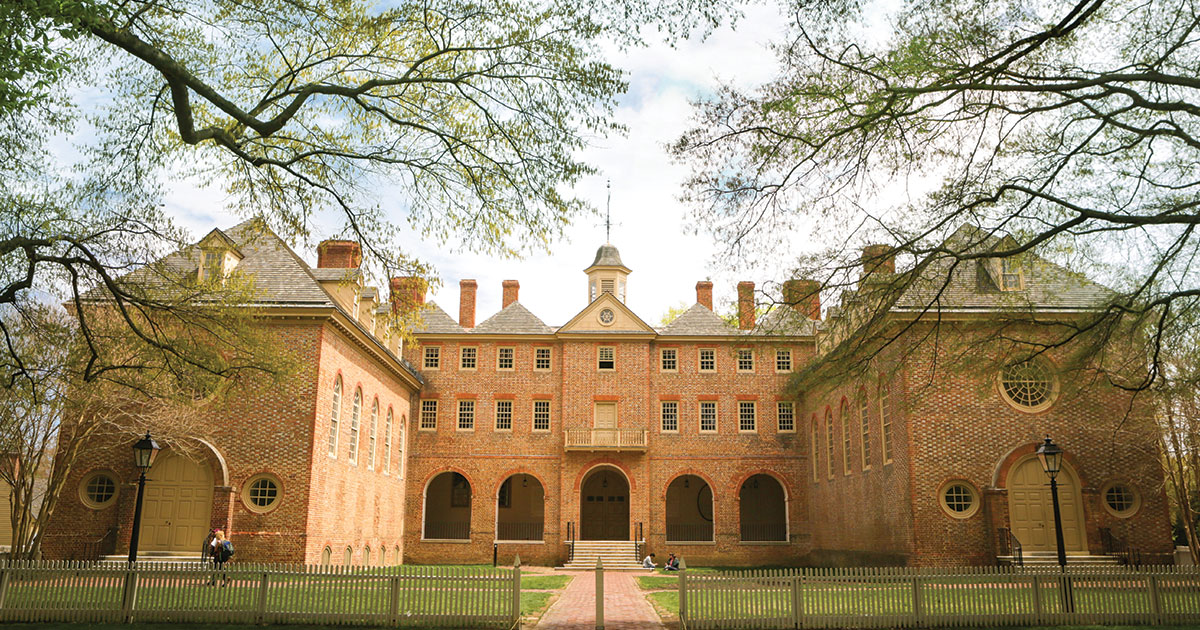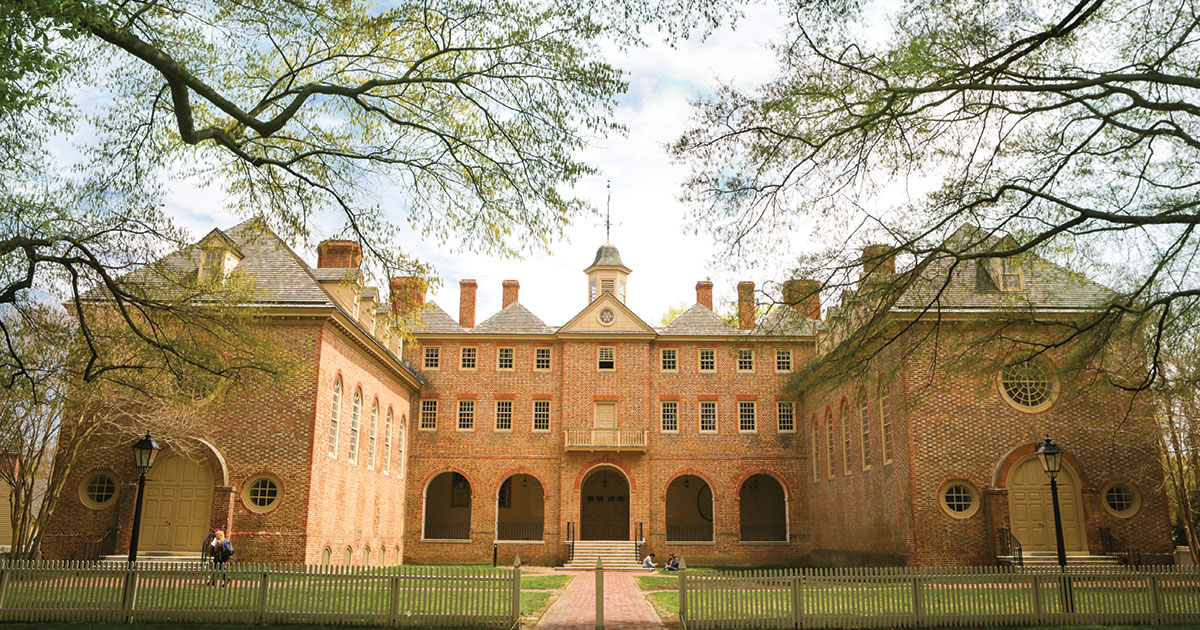Truth stretched and legend upheld

The oldest academic building in the country has drawn many students to its doors. The solid configuration of rectangles sits tranquilly in the tree-shaded green space of ancient campus, forming the tip of the triangulation of William & Mary's oldest buildings. Light beams through sturdy windowpanes that compose rectangular, circular and compass-headed arched windows. Students and alumni revere it, and even visitors to Colonial Williamsburg who wander across Confusion Corner understand that the Wren Building represents the epitome of an academic building: imposing, beautiful, erudite. Generations of college students have lounged lazily in its shadow on a Saturday afternoon, and generations have gathered in it, studied by its massive windows, attended ceremonies in its chapel and visited office hours within its walls.
Those walls have a legacy of their own. Construction on the building began in 1695. A fire in 1705 gutted the building, but funds from Queen Anne completed the reconstruction by 1716. Construction on the Wren Chapel ended in 1732. Another fire in 1859 reduced the structure, yet again, to a hollow shell. Just three years later, flames once more engulfed the academic hall when Union troops set fire to it.
Every time the Wren crumbled to ashes, carpenters and masons incorporated the old walls and foundations into each new iteration, encasing the memories of the past beneath the surface of the present. It is no wonder that our imaginations churn with fantastic tales of what could have been and what might be when we pass by it in the chill of the evening.
Perhaps we fabricate these stories because of the reverence in which the W&M community holds the building and the nearly palpable secrecy in which its stewards keep it. Apart from the occasional theology lecture, most students currently enter these halls only on occasions steeped in tradition and solemnity: Convocation, Yule Log, a fraternity or sorority initiation.
During these moments, students reflect on their place at this institution under the gaze of the portraits and busts of illustrious alumni and former kings and queens of Great Britain. Those paint and plaster likenesses once walked this earth as flesh and blood, literally breathing life into the institution and into the Wren Building itself. As we go through the motions of each ceremony, we barely take notice of them; they become a blur of unimportant decoration, the details of which would attract our attention only if they went missing. How much less do we know about the faculty who lectured here, the young men who lived in the halls, the soldiers hospitalized there during both the American Revolution and the Civil War?
An old expression holds that a pretty lie is better than the ugly truth. By the law of syllogism, an engrossing tale is better than a dull fact. We want to believe wholeheartedly in the supernatural mystique of the legends that somehow add prestige to the institution. Only in the oldest academic building in the United States might the spirit of a French soldier who died during the Revolution traverse its staircases, might the restless soul of the Enlightenment polymath Sir Christopher Wren lurk behind a door, and might passages lead to subterraneous burial sites. These rumors fly from the mouths of the student body, each generation embellishing and revising, adding and subtracting to the tales.
The stories stem from fact: the full and vibrant life of the 325-year-old university. As the walls have thickened as a result of multiple renovations, they reflect the layered history of the building itself: the people and the times. What lies in the building divulges pieces of the story, and the story does not always mirror the hallowed-halls-standing-firm-under-the-dappled-light-canopy-of-trees image that we have of it today.
Students and faculty both left the Wren all but empty to serve state and country during the American Revolution and the Civil War. Only marble plaques hanging in the center passage commemorate their names. Wounded French soldiers convalesced or died in the makeshift hospital within the building's walls for months after the battle of Yorktown in 1781. Just 80 years later, the building reacquired its hospital status, this time for Confederate troops. When the city fell in 1862, Union forces incorporated the rubble of the great institution that had produced the founders of our country into their eastern defensive line. A haunting depiction of the Lord Botetourt statue standing against blackened walls and a battle scene recounts the era.
Fodder for myths isn't limited to a record of events. The built environment of ancient campus summons us to make it our own, for the placid setting dares us to wonder what darkness lies veiled under the surface.
Under the floorboards of the Wren chapel rest the bones of "various old Virginians, such as Sir John Randolph, Lord Botetourt, Peyton Randolph, Bishop James Madison, Chancellor Robert Nelson and other worthies," according to a statement written in 1903 preserved in the Literary References to Wren Building, a 1931 Colonial Williamsburg research report. A report from the 1970s indicates that we haven't identified two of the people spending eternity in those vaults.
How peacefully the remains rest, we do not know. Faculty minutes of Nov. 22, 1859 reveal that the recent fire had cracked the vault containing "the body of Peyton Randolph, the president of the first American Congress, and this was only sufficiently broken to show the coffin of this distinguished patriot in an excellent state of Preservation." During Federal occupation of Williamsburg during the War, Union soldiers plundered the burial site and took silver name plates from the coffins, including that of Lord Botetourt's.
The draw of the sepulchers captivated fraternity boys in the 20th century. Paul Buchanan, director of architectural research at Colonial Williamsburg during the 1960s and '70s, discovered the Greek letters of Sigma Alpha Epsilon and Sigma Phi Epsilon scored into the side of Lord Botetourt's vault. Stubs of burnt candles, Busch bottles - still the campus fraternity beverage of choice - and a single bone left beside the opened coffin commemorated the event. Whispers currently circulate among the Greek community that one fraternity managed to steal piecemeal an entire skeleton and reassemble it. They supposedly keep the disintegrating bones locked away with their other secrets.
Perhaps those boys crept into the funerary space via the maze of tunnels that writhes beneath old campus. The twists and turns of the human-sized pipes provided heat to academic buildings decades ago. Susan Kern, director of the historic campus, says that the tunnels "are not friendly places" and that they have never intersected with the burial space beneath the floorboards of the chapel. In spite of this information, undergraduates persist in believing that the tunnels connect to the Wren - if not to the graves of our William & Mary forefathers, then to another place in the building. We wonder where they might take us, what secrets they might reveal.
To access the tunnels, to sneak into the burial space, to feel the chill of a lingering soul amounts to an adrenaline rush of mythic proportions to William & Mary students. Any encounter in the illicit spaces underlying the revered-by-all building of God, country and American academia is something to rehash with fellow adventurers when Saturday night folds into Sunday morning while bloody marys pour and fried eggs swim in oleaginous pools. Our collegian adventure tripping gives us tales to retell to the captive, wide-eyed audiences of our children and grandchildren when our most exciting days have passed and we live vicariously through our youthful memories. And what if we embellish our encounters all those years later? Spin fact into fantasy to create the stuff of myths?
This institution has harbored and produced incredible minds. It has stood the tests of rebellion, conflagration and economic hardship. We cherish its resilience and adore the accumulation of its history. We have confidence in the exceptionalism of every aspect of William & Mary , including its legends. This belief explains why we cling so closely to the campus' oral traditions and why we yearn to explore them and expand their rhetoric. Relish this aspect of William & Mary. After all, if dark secrets don't lurk within the building's several-foot-thick walls, where do we get the stories?

